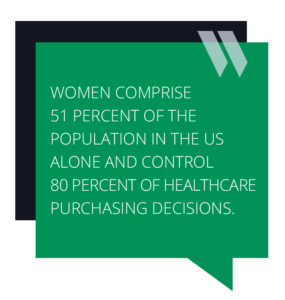Women deserve exemplary healthcare.
For too long, that’s been denied to us – whether it was the early days where women’s health concerns were dismissed as hysteria or hormones; cancer diagnoses were given to husbands, not wives; and even instruments – like stethoscopes – were designed to avoid even touching female patients. Today, women’s healthcare often continues to be suboptimal – and worse for women of color – with doctors believing women “exaggerate their pain” and medical research privileging men as ideal research subjects.
So what does great care look like?
It would be a comprehensive, holistic approach to the elements that make women’s healthcare unique – whether it’s dealing with chronic pain from endometriosis or PCOS, making choices about if and when to have a family, achieving a healthy pregnancy and delivery, or finding expert and available menopause care.
But unfortunately, a physician shortage means by 2050, there will be a shortfall of 22,000 obstetricians and gynecologists. That means those in the field will face higher patient demand and more pressure to deliver care that results in positive outcomes. A care team model is the only practical way women’s health practitioners can realistically support the needs of their patients. This patient-centric approach ensures that the work of caring for patients – from testing to appointment scheduling reminders to check-ins to the logistics of referrals – is spread across multiple people so that clinicians focus on diagnosing and treatment plans.
This approach works even more effectively with technology to provide foundational platform support, the kind that ensures care team members are always up to speed and on the same page with very little energy expended. In this way, the 167M women in the US can be better served. Here are six ways to achieve that goal.
Move toward aptly-named “whole person” care
‘Whole person’ care is a lovely phrase that simply means addressing the full spectrum of a patient’s needs in a single visit. Emerging healthcare start-ups (Tia is a great one) are increasingly oriented in this direction because it’s clear that merely addressing one aspect of care doesn’t produce optimal outcomes. Imagine a new mom, for example, coming to her doctor to say she was having trouble sleeping and getting prescribed sleeping pills. A whole person approach to care would spend part of the visit on the emotional and psychological components of this woman’s health – for example, is she having trouble sleeping because she’s anxious, a hallmark of postpartum depression?
Scaling compassionate care
The pressure is on for women’s health practitioners to move faster and help more patients, all while still delivering superlative care in a compassionate way. Technology can facilitate some of that speed through automation of more rote tasks like appointment scheduling and reminders, sending intake forms in advance of appointments, etc. This both frees up the burden on patients to make appointments and check in – and it frees up time so even more patients could potentially be seen and supported.
Putting everyone on the same page
A team-based care approach is all about collaboration at the core. But that collaboration can’t be smooth and easy without knowing what everyone’s doing. Women’s health providers often leverage a team based approach to care – from the doctor, RN, imaging to labs, an easily digestible patient synopsis is key. A solid technology platform ensures that all activities are logged and accessible – and makes it possible to pull in outside team members (such as specialists) as needed to ensure rapid onboarding. With everything in one place, it’s much easier to get up to speed so that new care team professionals can begin contributing much faster.
Personalize the patient approach
Patients today – not unreasonably – expect a more personal, tailored approach to healthcare. The good news is that this doesn’t have to be a heavy lift for care team members. Technology platforms can take most of the work out of this process. At a very fundamental level, it can allow patients to pick their communications preference – text, voice call, video conference, email – and also select the days and times they prefer to receive messages.
For providers, women’s health is often multi-disciplinary. That’s why choosing a technology that supports multiple programs, where each phase is customized to the condition and the person, is crucial. Women’s health can never be approached in a one-size-fits all way and having the patient be an active decider in their treatment plan means needing to adjust care plans quickly and efficiently.
Just the data that matters, when it matters
As any doctor could tell you, data overload is a real thing. Seeing too much, having to sort out what matters from what doesn’t, and being subjected to a constant stream of information causes decision fatigue and contributes to burnout. With technology, guardrails and rules can be established in order to surface the precise data that’s needed, when it’s needed, and no more.
And the parameters for real-time alerting can also be set so that when patients need more real-time, urgent interventions, care team members instantly know and can take action. That’s particularly important in women’s care, where medical issues like high-risk pregnancies, must be closely monitored.

Analyze for insights
With all data streams funneling into a single platform, it becomes much easier to analyze and develop insights with confidence when you have digestible data visualizations such as patient graphs and charts. Being able to see trends in a patient’s history is critical to being able to adjust, fine-tune and otherwise alter a treatment plan or care path in service of delivering a better outcome.
In short, this model provides better outcomes for patients – with convenience to boot because patients go one place and get every concern and need addressed. This is the future of care.
Women comprise 51 percent of the population in the US alone and control 80 percent of healthcare purchasing decisions. They’re increasingly aware they deserve the best in collaborative care: a holistic approach that addresses their unique physical, mental and emotional health needs. Fortunately, as more women’s health practitioners adopt a care team approach, more women than ever before will experience the care they deserve.
On a positive note, with femtech on the rise and investors increasingly funding female-led women’s health startups, we’re seeing so many amazing innovations emerge. And it’s about time. Seeing this shift occur – and this massive, oddly underserved audience getting the support they deserve – is so exciting. Being there to help support these incredible programs is even better.



